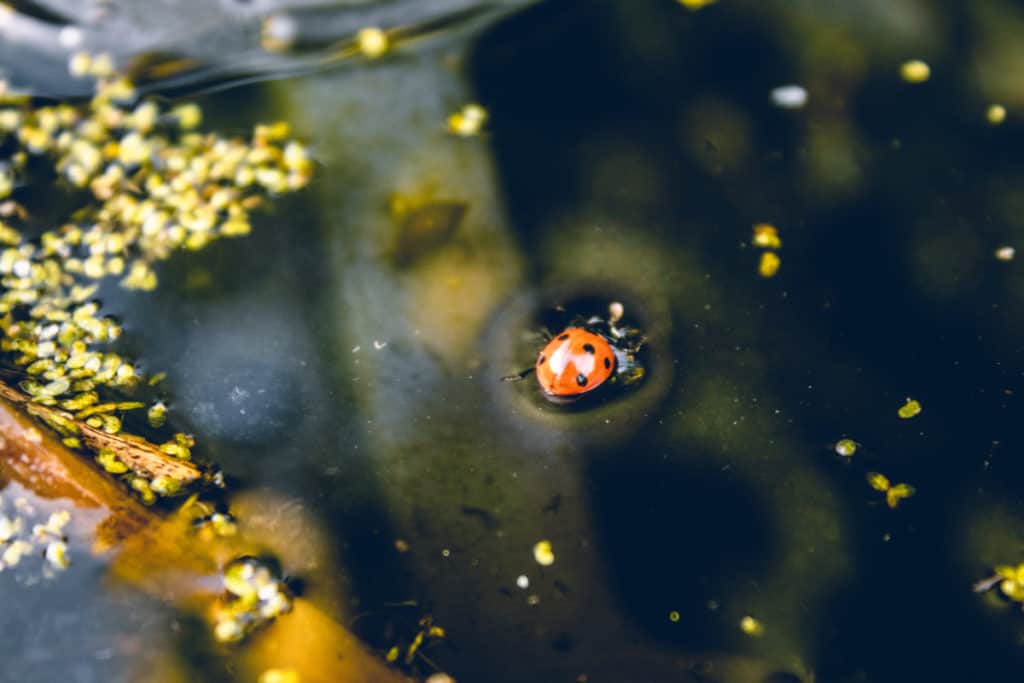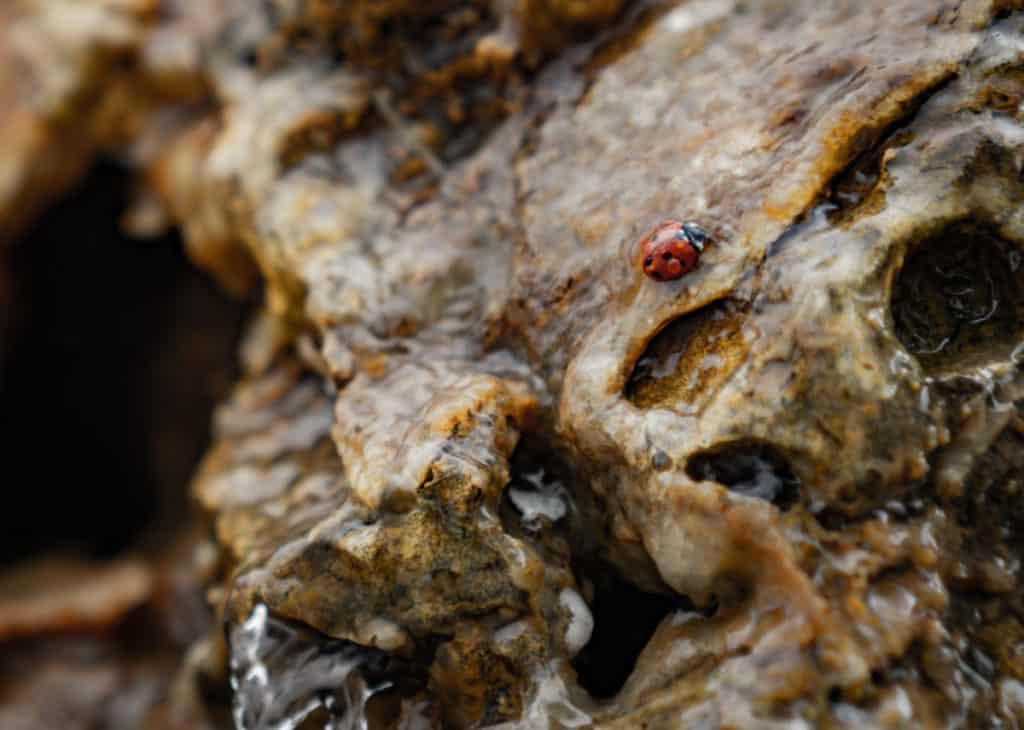Most insects are not renowned swimmers. But what about ladybugs? Can they survive a swim in a puddle or a swimming pool?
Can ladybugs swim? Yes, ladybugs can swim much better than most insects, however, if they are in the water their primary intention of reaching dry land as soon as possible. Ladybugs float and can swim for long stretches because they have stores of energy due to their protein-rich diet of aphids.
There is more detail that needs explaining as to why ladybugs are such resilient swimmers. Keep reading as we elaborate on their consumption of oxygen and respiratory process. Also just how ladybugs can end up swimming in the first place.
How Do Ladybugs Swim In Water?
These tiny critters paddle with their legs but also they float which keeps them from drowning. Unlike humans, they do not breathe through their mouths when swimming.

The ladybug’s elytra, their colorful shell, helps float the ladybug’s abdomen better than most other insects. For example, bees breathe in the same way but their abdomens don’t float as much meaning they drown more easily.
Their abdomen contains the spiracles for breathing and the abdomen area is above water since the beetle is floating. So the spiracles do not get immersed in water.
A muscular valve regulates the intake and expulsion of air. Once the ladybug “inhales” oxygen through the spiracles, a sponge filters the incoming air, while releasing the outgoing air and also acts as a stop gate for the water. This prevents it from entering the breathing system. As long as the water doesn’t enter the ladybug’s respiratory system there, it continues breathing and swimming along.
But most important is the fact that the ladybug closes its spiracles when in water, and the air already in the beetle’s system is what they rely on until they reach a dry space. You may see a beetle hanging onto a dry branch in the water. It is literally catching its breath and taking in oxygen.
Compare this to a water beetle, which, on the other hand, has adapted to living in the water. Although it is very similar to a ladybeetle it spends all its time on the water and has to learn to survive. The resting position of a water beetle is with its head submerged underwater. It raises its abdomen so that the spiracles are outside the water surface and it can breathe.
Water beetles can also dive and swim efficiently in the water. So in preparation, they store enough air supply under their wings for breathing while they swim or underwater. The bubble of air underneath the elytra of the water beetle also prevents water from entering the spiracles.
However, you may encounter a ladybug underwater for a short period. Ladybugs can also swim or dive underwater without struggling if they have enough oxygen. That proves that ladybugs can hold their breath and conserve their oxygen reserves in water, at least for a while.
Can A Ladybug Drown In Water?
Unfortunately, yes they can. Despite their ability to swim and float, these little beetles get tired, and with the fatigue comes the high likelihood to drown. Just like any other land-based animal a ladybug has its limits when it comes to endurance.
You will notice that ladybugs take shelter during rainy seasons and also they do not hatch their eggs during this time. Some people use water to get rid of ladybugs by saturating their habitat with hard water sprays and drowning them.
A ladybug can last around 30 seconds to 4 minutes in water before needing oxygen. And without oxygen, they cannot sustain their ability to swim.
How do ladybugs find themselves in the water?
There are two main ways a ladybug finds itself in a water body: During the rainy season or when you pour too much water into their habitat.
The Rain
During the wet season, a group of ladybugs bunched together may be washed away from tree trunks or under leaves, ending up as a red drift in a water body. Considering the fact that a raindrop is as big as the ladybug itself, it is not surprising that rainfall can overwhelm ladybugs and sweep them away.

Also, as it rains the water is constantly moving, and even puddles and ponds are pounded by thousands of drops constantly so the ladybug cannot swim confidently in such uncontrollable conditions. The likelihood of drowning during a rain event is high.
Watering Plants
Watering the plants typically entails using a lot of flowing water from the hose. The consistent strong jet of water can knock the ladybug about injuring or overwhelming them in water without a way to come out. Ultimately they will drown in such a scenario.
Windy Conditions
When it is very windy a ladybug can be carried away landing in a water body. A typical ladybug only weighs about 0.2 grams similar, to a paper clip. If the ladybug’s habitat is close to a water body, with that weight and the strength of a gust of wind, you may find a couple of lady beetles floating around from time to time.
Attempting To Get A Drink
Ladybugs do not go to the river to drink. They may lean into a droplet to drink and get swept away into a larger water body. The beetles use their mandibles and palps to draw droplets of water inwards into the labium.
They need water to survive and most of the time they get their water from the food they eat. However, during the summer months when soft-bodied insects become scarcer and plant life is not as juicy, they have to get a drink from water droplets and sometimes a small puddle around them. Accidentally they may fall into a puddle during the process.

Remember that a drop of water is as big or bigger than a ladybug. Two to three drops are sufficient for the needs of this little critter.
We do have an entire article on what ladybugs like to drink. If you are interested the article is called, What do Ladybugs Drink?
How Does Water Impact A Ladybug’s Ability To Fly?
In comparison to water beetles, a ladybug’s ability to fly can be hampered when it is doused in water or fluid. That is one of the reasons why they are so easy to kill using a flood of water: they can’t get away. Their elytra (the front wings) are more of a covering and protective shield that protect its delicate, flying wings underneath.
To take off the ladybug needs to unfold the wings while swinging the elytra out of the way. While in the water, there is an increased risk of the water getting on the wings and making them wet and heavy. That can prevent take-off, and if the ladybug is exhausted from swimming for long and is low on oxygen, the chances of taking off reduce significantly.
Also, the ladybug needs to launch itself into the air from firmer ground and water is not. It is easier for the lady beetle to crawl onto a stick, blade of grass, or any dry patch and take off from there.
We take a deep dive (excuse the pun) into the flight of ladybugs in another article we have written. If this topic interests you the article is called, Do Ladybugs Fly?
Do fish eat ladybugs?
Ladybugs release a noxious secretion that deters most of their predators including fish. The alkaloid-rich fluid is contained in their joints and it makes it extremely hard to enjoy a ladybug meal. Also, ladybugs are known to taste bitter.
Unfortunately, ladybugs are also poisonous to pets like fish, cats, and dogs. The damage that the fluid secreted causes to the fish’s mouth are likened to that of a chemical burn and it also occurs when a dog or cat eats a ladybug.
Also, if the fish ingests the hard shell of the ladybug it may have a problem digesting it and it can cause blockage in the digestive system. Ultimately, the fish will die. The black ladybugs with small red spots, also known as the pine ladybug, is among the most toxic species. They are also quite prevalent in North America.
The orange species, also known as Asian lady beetles, are the most toxic. Apart from killing fish they also cause allergic reactions in some people.
The Wrap Up
A ladybug is a small insect, making it vulnerable to the elements, especially water. But don’t give up too quickly on a ladybug in a water body. They are more resilient than you can imagine. If you come across one who looks to be struggling be sure to lend them a helping hand and get them out of the water safely.
Sources
https://www.buglogical.com/ladybugs-faq.html
https://en.wikipedia.org/wiki/Water_beetle
https://www.healthline.com/health/are-ladybugs-poisonous#summary
